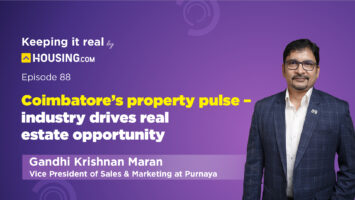Mixed-use developments are reshaping urban living in India by combining residential, commercial, and recreational spaces within a single, well-planned project. As cities expand and commuting becomes more time-consuming, these integrated developments offer homebuyers a practical solution for a convenient and connected lifestyle. This guide explores what mixed-use projects are, how they function, and what buyers should consider before investing.
What is a mixed-use development?
A mixed-use development is a real estate project that brings together multiple property types, typically residential, retail, office, and recreational, within the same complex or community. The aim is to create a self-sufficient environment where daily needs like shopping, work, dining, and leisure are accessible without leaving the premises.
Unlike traditional residential neighbourhoods, mixed-use projects are designed to promote walkability, efficient land use, and vibrant social interaction. In India, these developments are gaining popularity in both metro cities and emerging urban hubs, often positioned near transport corridors and commercial hotspots.
Key components of a mixed-use development
A well-designed mixed-use development brings together various functional spaces to create a cohesive, self-sustained urban environment. The key components typically include:
Residential spaces
These form the core of most mixed-use projects. Options range from apartments and villas to serviced residences. The residential component is usually designed for comfort, security, and proximity to amenities, offering homebuyers the convenience of living close to work and leisure spaces.
Commercial zones
Office complexes, co-working spaces, and business centres are integrated to attract working professionals and entrepreneurs. These zones increase footfall and add to the economic vibrancy of the development, making it ideal for both end-users and investors.
Retail establishments
Retail outlets, including supermarkets, pharmacies, cafes, salons, and boutique stores, are typically located on the ground floor or in dedicated shopping areas. They ensure that daily necessities and lifestyle services are easily accessible to residents and visitors alike.
Public and recreational spaces
Parks, playgrounds, jogging tracks, clubhouses, and event plazas help build a sense of community and promote healthier living. These open spaces also act as social hubs, encouraging interaction among residents of different age groups.
Transportation access
Proximity to major roads, metro stations, and bus terminals is a defining feature of successful mixed-use projects. Internal infrastructure like ample parking, dedicated drop-off zones, and pedestrian-friendly paths further improve connectivity and ease of movement.
Institutional and cultural facilities
Schools, healthcare centres, art galleries, and community halls are increasingly being included in mixed-use layouts. These elements serve essential social functions and support long-term livability, especially for families and senior citizens.
Types of mixed-use property developments in India

Mixed-use developments in India can vary widely in scale, structure, and layout. Broadly, they can be classified into the following types:
Vertical mixed-use developments
In these projects, different functions are stacked within a single building. For example, retail outlets may occupy the ground floors, office spaces on the middle levels, and residential units on the upper floors. This format is common in space-constrained urban areas like Mumbai and Bengaluru.
Horizontal mixed-use developments
Here, residential, commercial, and recreational zones are spread across a larger area but within the same project boundary. Townships and gated communities often follow this model, offering standalone office buildings, retail blocks, parks, and residential towers coexisting across the layout.
Transit-oriented developments (TODs)
These developments are built around major public transport hubs such as metro stations, railway terminals, or bus depots. With seamless access to public transit, they aim to reduce reliance on private vehicles and encourage walkable, sustainable urban living.
Lifestyle or community-centric developments
These are designed with a strong focus on leisure, entertainment, and social spaces. They often include cafes, multiplexes, wellness centres, and community areas, in addition to residences and retail units, catering to buyers seeking a holistic lifestyle experience.
Design principles for a mixed-use development
Successful mixed-use developments are guided by thoughtful design principles that balance functionality, accessibility, and community needs. Below are the key principles that shape well-executed projects:
- Integration: Blend residential, commercial, and retail functions in a way that allows them to complement and support one another, creating a unified living and working environment.
- Connectivity: Prioritise smooth transitions between zones by incorporating pedestrian-friendly walkways, cycle tracks, and convenient links to public transport systems for hassle-free movement.
- Flexibility: Design with future adaptability in mind. Spaces should be versatile enough to accommodate evolving residential and commercial demands over time.
- Sustainability: Emphasise eco-conscious planning through energy-efficient buildings, use of sustainable materials, rainwater harvesting, and green landscaping to lower the environmental footprint.
- Public spaces: Include inviting, open areas such as plazas, gardens, and community squares that foster social interaction and contribute to the overall liveability of the development.
- Density management: Utilise available land efficiently by increasing built density without compromising on ventilation, privacy, or access to light and green space.
- Aesthetic value: Incorporate appealing architectural styles, cohesive urban design, and visually engaging façades to enhance the overall look and identity of the development.
Benefits of buying a home in a mixed-use development
Mixed-use developments offer several advantages for homebuyers, especially those seeking convenience, value appreciation, and an enhanced lifestyle. Key benefits include:
- Easy access to daily essentials: With shops, supermarkets, pharmacies, and eateries located within or near the residential area, residents save time and effort on everyday errands.
- Improved work-life balance: Living close to office spaces or coworking hubs reduces commute times, allowing more time for family, hobbies, and personal well-being.
- Better lifestyle amenities: Most mixed-use projects offer premium amenities such as gyms, clubhouses, landscaped gardens, and entertainment zones, contributing to a higher quality of life.
- Enhanced property value: Homes in well-planned mixed-use developments often appreciate faster due to high demand, strategic locations, and proximity to commercial hubs.
- Strong rental potential: Such properties attract a wide pool of tenants, especially working professionals and business travellers, making them ideal for investors seeking steady rental income.
- Vibrant community living: The mix of residential and commercial activity encourages social interaction and a sense of community, particularly in developments with shared public spaces and regular events.
Challenges of buying a home in a mixed-use development
While mixed-use developments offer many advantages, they also come with certain challenges that homebuyers should consider before investing:
- Increased noise and footfall: The presence of commercial establishments and public areas can lead to higher noise levels and more foot traffic, particularly during business hours or weekends
- Privacy concerns: With a constant flow of visitors and activity in retail and office zones, residents may experience less privacy compared to standalone residential complexes.
- Higher maintenance costs: Shared infrastructure, 24/7 security, and upkeep of public amenities often result in higher maintenance fees for homeowners.
- Potential for overcrowding: If not well-planned, mixed-use projects can become congested, especially in high-density areas where commercial demand is high.
- Parking and traffic issues: The mix of residential and commercial users can strain parking availability and internal traffic flow, especially if visitor management is not well regulated.
- Uneven development phases: In large projects, residential units may be ready before commercial areas are operational (or vice versa), leading to temporary inconvenience for early occupants.
Key factors to consider before investing in a mixed-use development
Investing in a home within a mixed-use development requires careful evaluation of several factors to ensure long-term value and convenience. Here’s what buyers should keep in mind:
- Developer reputation: Choose a developer with a proven track record in delivering large-scale or mixed-use projects. Timely delivery and quality construction are especially important in integrated developments.
- Zoning and legal clearances: Verify that the project complies with local zoning regulations and has received all necessary approvals, including RERA registration, environmental clearances, and municipal permissions.
- Quality and placement of commercial units: The success of the commercial component can impact property value. Look for developments anchored by reputable brands and ensure commercial activity is suitably distanced from residential blocks.
- Layout and infrastructure planning: Assess how well the development is planned. Check for designated areas for each use, smooth internal traffic flow, efficient waste management, and emergency access routes.
- Connectivity and location: Proximity to key transport hubs, office corridors, schools, and hospitals enhances the utility and resale value of the property.
- Maintenance and security systems: Evaluate the project’s long-term maintenance plan and security measures. Mixed-use projects require robust systems to manage both residential and commercial demands.
- Occupancy and phasing strategy: Find out whether the residential and commercial areas will be delivered simultaneously. A clear phasing plan helps avoid future disruption and gives insight into the development timeline.
Tips for first-time buyers in mixed-use developments
If you’re buying a home in a mixed-use development for the first time, a few practical steps can help ensure a smoother experience and smarter investment:
- Visit the site at different times: Observe the activity levels during weekdays, evenings, and weekends. This helps assess noise levels, traffic flow, and the actual use of public areas.
- Review the master plan thoroughly: Understand how the residential, commercial, and retail spaces are distributed. Check if the design ensures privacy and security for residents.
- Ask about commercial tenants: If the commercial section is already leased, inquire about the nature of businesses operating there. Anchor tenants like banks, grocery stores, or cafes can be a value-add, while bars or event venues might lead to disturbances.
- Clarify maintenance responsibilities: Understand how maintenance charges are split between residential and commercial zones and what services are covered under each.
- Consider long-term viability: Think beyond your immediate lifestyle needs. Will the development remain relevant and well-maintained 5–10 years down the line? Look at surrounding infrastructure, future development plans, and resale trends.
- Talk to existing residents (if any): If the project is partially occupied, interacting with current homeowners can offer useful insights about day-to-day experiences that brochures may not reveal.
Housing.com POV
Mixed-use developments represent more than just a real estate trend. They reflect a shift in how India’s urban population wants to live, work, and engage with their surroundings. These integrated projects serve as a key driver of next-generation housing solutions, especially in high-density cities where space and time are at a premium.
For homebuyers, mixed-use developments offer the rare combination of convenience and capital appreciation. However, the success of such an investment depends heavily on how well the project is planned, executed, and maintained. A beautifully designed space with poor traffic management or mismatched commercial tenants can quickly lose its appeal and value.
Buyers should approach mixed-use homes not just as lifestyle upgrades, but as strategic investments that require the same due diligence as buying into a purely residential project, if not more. The blend of commercial and residential uses means that external factors like tenant mix, foot traffic, and retail success can directly impact a resident’s living experience.
Mixed-use projects work best when residential comfort is not compromised by commercial vibrancy. Thoughtful design, controlled density, and high-quality infrastructure are non-negotiables. Developers must also be held to account for long-term upkeep and clarity in defining residential vs commercial zones.
FAQs
Are mixed-use developments suitable for families with children?
Yes, many mixed-use projects include schools, parks, and healthcare facilities, making them suitable for families. However, it’s important to check if these amenities are thoughtfully located away from high-traffic commercial areas.
Do banks offer home loans for properties in mixed-use developments?
Most leading banks and NBFCs do offer home loans for residential units in mixed-use projects, provided the property is RERA-registered and the developer has a clean approval track record.
Can residents influence what businesses are allowed in the complex?
In most cases, residents have limited say unless the project is structured as a cooperative housing society or RWA-managed property. However, some developers do consider buyer feedback during tenant selection in early phases.
Are resale prospects strong in mixed-use developments?
Resale value depends on location, build quality, and commercial success of the project. Units in well-maintained, balanced mixed-use developments often attract professionals and investors, leading to better resale prospects over time.
How is security typically managed in these projects?
Security is usually handled through integrated systems, which include CCTV surveillance, gated access, and 24/7 guards, with separate access points for residential and commercial areas to ensure safety without compromising convenience.
| Got any questions or point of view on our article? We would love to hear from you. Write to our Editor-in-Chief Jhumur Ghosh at jhumur.ghosh1@housing.com |







